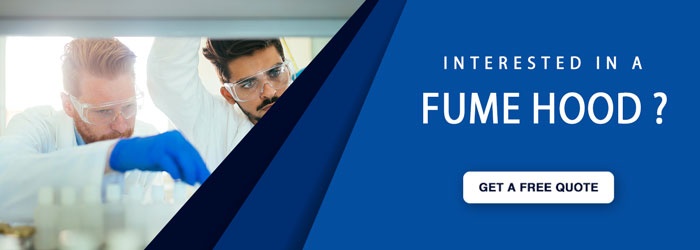Ductless fume hoods are some of the most important pieces of equipment in a laboratory, as they’re responsible for serving as a physical barrier between an employee and the harmful fumes, fires and spills that can occur in this type of workspace.
When used incorrectly, a fume hood can also be one of the most dangerous places in the laboratory. That’s why it’s important for companies to put strict procedures in place to ensure all safety protocols are followed.
As one often-repeated quote points out, “Safety isn’t expensive. It’s priceless.”
Here are seven ductless fume hood safety rules that should be followed to ensure your laboratory is operating at top safety levels.
Keep Employee Training Up To Date
 Safety procedures are constantly being updated, and employee turnover is common in any workspace. Although this rule isn’t one that will necessarily require action every day, it’s critical to keep employee training at the forefront in any laboratory.
Safety procedures are constantly being updated, and employee turnover is common in any workspace. Although this rule isn’t one that will necessarily require action every day, it’s critical to keep employee training at the forefront in any laboratory.
It’s essential to ensure anyone new who comes on board is fully trained in operating the ductless fume hood. Although an employee may have been trained in fume hood use, that experience may be with another type of fume hood.
Ducted and ductless fume hoods are similar in their purpose in that they remove dangerous fumes, vapors and particles, but they are constructed differently and each requires its own training. Ducted fume hoods are considered a more standard choice, and therefore are found in more laboratory settings. This type of fume hood has ventilated enclosures, operates within the framework of your building infrastructure and pulls toxic fume out of your laboratory through an HVAC system.
But ductless fume hoods are becoming more popular, especially as more laboratories are having to quickly expand to meet today’s demand for medical testing and supplies. Ductless fume hoods operate off a carbon filter system, which recirculates filtered air into the laboratory. They are self-contained and work well for laboratories where mobility is necessary.
Even current employees who use a ductless fume hood should receive regular refresher training, especially if a new chemical is being used under the hood.
Perform A Safety Check Prior To Use
Before lab workers use a ductless fume hood, they should ensure it is in top working order by following a checklist designed to catch any outside influences that could disrupt its operation.
This checklist should include the following:
- Ensure the hood sash is opened to the proper height to provide the proper level of protection.
- Check the air gauge to ensure the airflow is within the required range.
- Make sure the exhaust fan is working so that hazardous chemical fumes can escape.
- Check the baffles in the exhaust fan, since these keep airflow uniform.
- Double check there are no spark sources nearby that can cause a fire or explosion.
- Examine the air filters to ensure they are not clogged.
Our Fume Hood Safety Checklist For Everyday Use is an easy-to-follow guide that outlines what elements your checklist should include and why.
Know Your Chemicals
 Employees may work with a variety of chemicals under a ductless fume hood. If your lab has yet to purchase a ductless fume hood, keep in mind that a list of chemicals and the quantities that will be used in the hood should be developed to determine whether this type of fume hood will adequately handle your workload.
Employees may work with a variety of chemicals under a ductless fume hood. If your lab has yet to purchase a ductless fume hood, keep in mind that a list of chemicals and the quantities that will be used in the hood should be developed to determine whether this type of fume hood will adequately handle your workload.
Most ductless fume hoods should only be used as light-duty or process-specific fume hoods. Other filtered fume hoods can be used for a wide range of chemicals, but larger chemical volumes will always shorten filter life.
Once a ductless fume hood is installed and is in operation, workers must understand the potential reactions of the chemicals being worked with, since dangerous interactions could cause an explosion or other hazardous reaction.
If a user is unsure of potential reactions, also have a chemical’s Material Safety Data Sheet available to provide more information.
Wear The Proper Protection
If your fume hood is located in a clean room, you’ll likely need to wear clean room garments. Some of these garments can offer an added layer of protection for fume hood users.
Typical garments you may need to wear based on your application include eye protection like goggles and face shields, gloves, lab coats and coveralls.
When using a fume hood, spark sources can be a major concern. One spark source is electrostatic discharge (ESD). Polyester is often used to create static dissipative fabric, which can be ideal for controlled environments where ESD is a concern.
Polypropylene, on the other hand, allows moisture to evaporate more quickly than traditional clothing. It is also resistant to many acids and alkalis that may be used under a fume hood.
Practice Safety During Use
 You may be set up and ready to go, but it’s imperative not to let down your guard while using a fume hood.
You may be set up and ready to go, but it’s imperative not to let down your guard while using a fume hood.
For example, never let your head enter the fume hood beyond the sash, and try to limit motion around and in front of the hood while you’re working. This can cause the fume hood to vibrate and disrupt airflow.
While you checked the baffles and the exhaust fan prior to use, continue to check whether the baffles have become blocked and that the exhaust fan is still properly working.
Finally, keep all materials at least six inches from the sash opening inside of the hood at all times, and when not working in the hood, close the sash.
Never Store Chemicals In The Hood
Never use a fume hood to store chemicals. They should instead be stored in industrial cabinets that are equipped to hold hazardous chemicals.
Unlike fume hoods, industrial cabinets made of steel or stainless steel provide an extra layer of protection when using corrosive materials that can easily damage or contaminate surfaces.
However, while chemicals should not be stored in the fume hood, it is permissible to store large equipment in the fume hood as long as the equipment is on top of blocks. This allows airflow under the equipment.
Always Have A Plan In Place If An Accident Occurs
Finally, no one likes to think an accident will occur, but if one does, it’s imperative to be prepared.
In fact, the most important step to take when a fume hood accident occurs is being able to put a quick and effective response in place. Your contingency plan should include the following:
Step 1: Respond to the accident first. This includes putting out any fires, containing any spills and evacuating the area if necessary. Contact emergency services and attend to the injured.
Step 2: Investigate the cause. This should be done right away to prevent important data from being lost and witnesses from forgetting details that can help prevent a similar accident from happening again.
Step 3: Prepare a root cause analysis. This identifies the primary source of a problem. In the case of a ductless fume hood accident, an analysis may include possible causes that led to the accident or what sequence of events led up to it. Questions to ask include whether there were any conditions that allowed the accident to occur and whether any communication challenges led to a proper response. Report this information to management.
Step 4: Fix the problem(s). Once the cause of the accident has been determined, you can take the appropriate steps to ensure it does not happen again. This may involve putting new procedures in place.
Step 5: Test new procedures. Any new safety measures put into place should be monitored and tested to ensure they are successful.
With any state-of-the-art piece of equipment, it is critical to have all safety measures put into place to ensure workplace compliance and the safety of employees. Ductless fume hoods play an important role in ensuring the safety of a laboratory, but implementing regular training and setting standards for use is necessary so that the equipment can work how it is intended.


